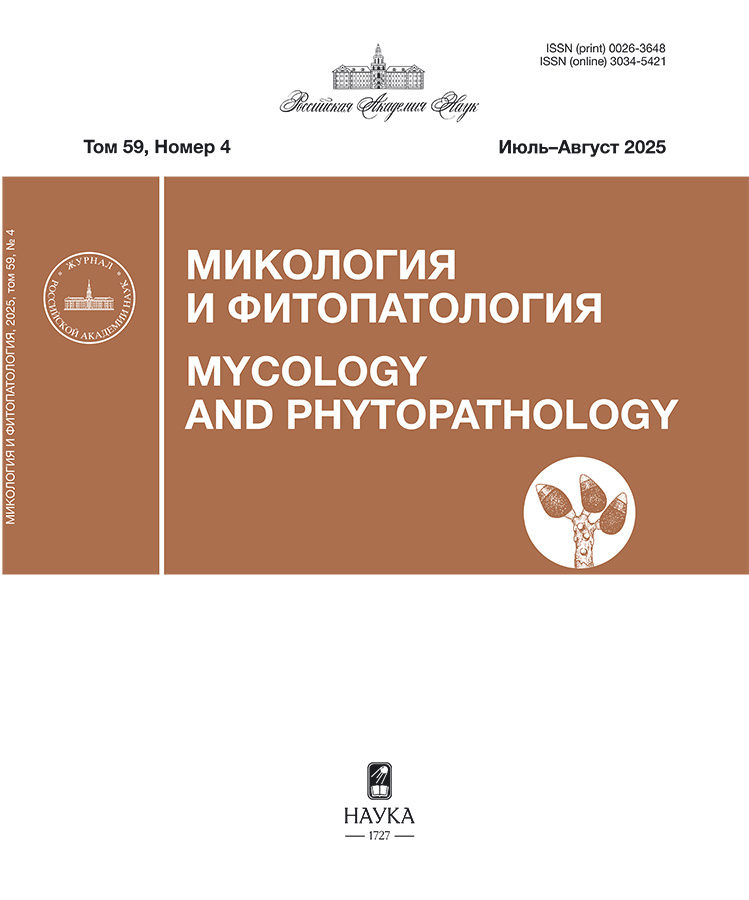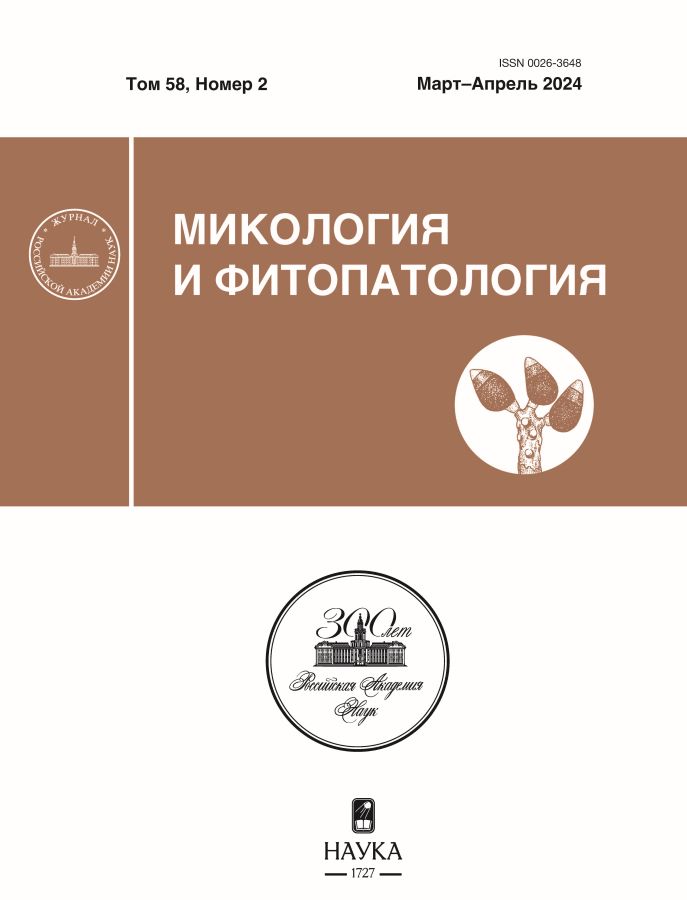Unique findings of Phoma-like fungi associated with soybean
- Authors: Gomzhina М.М.1, Gasich E.L.1
-
Affiliations:
- All-Russian Institute of Plant Protection
- Issue: Vol 58, No 2 (2024)
- Pages: 143-160
- Section: PHYTOPATHOGENIC FUNGI
- URL: https://permmedjournal.ru/0026-3648/article/view/655957
- DOI: https://doi.org/10.31857/S0026364824020062
- EDN: https://elibrary.ru/vozrsf
- ID: 655957
Cite item
Abstract
Ascochyta leaf blight of soybean is a widespread disease caused by several closely related Phoma-like species, this disease often leads to significant crop losses. Among Phoma-like species from Didymellaceae family, the most frequently associated with symptomatic soybean tissues are species of the genera Boeremia and Didymella. Currently reliable species identification in Didymellaceae relies on polyphasic approach based on consolidated species concept and combined molecular phylogenetic, micromorphological and cultural features. At least three loci are commonly used for reconstruction of the molecular phylogeny of Didymellaceae: internal transcribed spacer (ITS) of the ribosomal DNA, partial RNA-polymerase II gene (rpb2), and β-tubulin (tub2). As a result of long-term phytosanitary monitoring of soybean crops, soybean leaves with symptoms of Ascochyta blight were collected from major soybean producing areas of Russia. From surface sterilized plant tissues more than 100 isolates of Phoma-like fungi were obtained and stored in the collection of pure cultures of the Laboratory of Mycology and Phytopathology (MF, All-Russian Institute of Plant Protection). Most of them, as a result of multilocus phylogenetic analysis, were identified as Boeremia and Didymella species. Eight isolates were identified as species of other genera, suspected to be rare findings. The aim of this study was to identify these eight isolates based on multilocus phylogenetic analysis, as well micromorphological, cultural, and pathogenicity data. Multilocus phylogenetic analysis has resulted in identification of all eight isolates to species level. Single isolate from the Ryazan region was Neoascochyta graminicola. Three other from three different districts of the Amur region were Remotididymella capsici. Two isolates from the Primorskiy territory and Amur region were Stagonosporopsis heliopsidis. Another two from two districts of the Amur region were S. stuijvenbergii. Pathogenicity tests have resulted in conclusion, that all studied isolates were not pathogenic for soybean leaves. Probably, these Phoma-like species are associate with soybean as saprophytes or endophytes. For all these Phoma-like species Glycine max was detected as substrate for the first time. Neoascochyta graminicola is widespread in Europe in association with Poaceae plants. There are only two findings of Remotididymella capsici in the world, both from leaves of Capsicum annuum. First finding was made in the former USSR in 1977 and was identified based on only morphological features. Second findings was collected in the Fiji and verified with multilocus phylogenetic analysis. Stagonosporopsis heliopsidis isolates were revealed in the USA, Canada, Netherlands and Russia and this fungus was believed to be specific for Asteraceae plants. Isolates of Stagonosporopsis stuijvenbergii are known only from soil in the Netherlands. Thus, such species as Neoascochyta graminicola and Stagonosporopsis stuijvenbergii were revealed in the Russia for the first time. Studied Remotididymella capsici isolates were first confirmed findings of this fungus in Russia. Additionally to detailed phylogenetic data, the manuscript is supplement with a detailed description of the cultural and micromorphological features of all species.
Full Text
About the authors
М. М. Gomzhina
All-Russian Institute of Plant Protection
Author for correspondence.
Email: gomzhina91@mail.ru
Russian Federation, St. Petersburg
E. L. Gasich
All-Russian Institute of Plant Protection
Email: elena_gasich@mail.ru
Russian Federation, St. Petersburg
References
- Abramov I.N. Fungal diseases of soybean in the Russian Far East. Vladivostok, 1931. (In Russ.)
- Abramov I.N. Diseases of agricultural crops in the Russian Far East. Khabarovsk, 1938. (In Russ.)
- Aveskamp M.M., de Guyter J., Crous P.W. Biology and recent developments in the systematics of Phoma, a complex genus of major quarantine significance. Fungal Diversity. 2008. V. 31. P. 1—18.
- Aveskamp M.M., Verkley G.J.M., de Gruyter J. et al. DNA phylogeny reveals polyphyly of Phoma section Peyronellaea and multiple taxonomic novelties. Mycologia. 2009. V. 101 (3). P. 363—382. https://doi.org/10.3852/08-199
- Aveskamp M.M., de Gruyter J., Woudenberg J.H.C. et al. Highlights of the Didymellaceae: a polyphasic approach to characterise Phoma and related pleosporalean genera. Stud. Mycol. 2010. V. 65. P. 1—60. https://doi.org/10.3114/sim.2010.65.01
- Boerema G.H., Gruyter J., Noordeloos M.E. et al. Phoma identification Manual. CABI Publishing, L., 2004.
- Bondartseva-Monteverde V.N. Ascochyta capsici. Monitor Phytopath. Sect. Chief Bot. Gard. R.S.F.S.R. 1923. V. 12. P. 70—72. (In Russ.)
- Bondartseva-Monteverde V.N., Vasilevskiy N.I. To biology and morphology of several Ascochyta species associated with Fabaceae. Trudy botanicheskogo instituta AN SSSR. Ser. 2. Sporovye Rasteniya. 1940. V. 4. P. 345—376. (In Russ.)
- Boyle J.S., Lew A.M. An inexpensive alternative to glassmilk for DNA purification. Trends Genetics. 1995. V. 11 (1). P. 8. https://doi.org/10.1016/S0168-9525(00)88977-5
- Carbone I., Kohn L.M. A method for designing primer sets for speciation studies in filamentous ascomycetes. Mycologia. 1999. V. 91. P. 553—556. https://doi.org/10.2307/3761358
- Chen Q., Jiang J.R., Zhang G.Z. et al. Resolving the Phoma enigma. Stud. Mycol. 2015. V. 82. P. 137—217. https://doi.org/ 10.1016/j.simyco.2015.10.003
- Chen Q., Hou L.W., Duan W.J. et al. Didymellaceae revisited. Stud. Mycol. 2017. V. 87. P. 105—259. https://doi.org/10.1016/j.simyco.2017.06.002
- Crous P.W., Hawksworth D.L., Wingfield M.J. Identifying and naming plant-pathogenic fungi: past, present, and future. Ann. Rev. Phytopathol. 2015. V. 53. P. 247—267. https://doi.org/10.1146/annurev-phyto-080614-120245
- Deb D., Khan A., Dey N. Phoma diseases: epidemiology and control. Plant Pathol. 2020. V. 69 (7). P. 1203—1217. https://doi.org/10.1111/ppa.13221
- Doyle J.J., Doyle J.L. Isolation of plant DNA from fresh tissue. Focus. 1990. V. 12. P. 13—15. https://doi.org/10.1007/978-3-642-83962-7_18
- Hou L.W., Groenewald J.Z., Pfenning L.H. et al. The Phoma-like dilemma. Stud. Mycol. 2020a. V. 96. P. 309—396. https://doi.org/10.1016/j.simyco.2020.05.001
- Hou L., Hernández-Restrepo M., Groenewald J.Z. et al. Citizen science project reveals high diversity in Didymellaceae (Pleosporales, Dothideomycetes). MycoKeys. 2020b. V. 65. P. 49—99.https://doi.org/10.3897/ mycokeys.65.47704
- Gomzhina M.M., Gannibal Ph.B. Modern systematics of the genus Phoma sensu lato. Mikologiya i Fitopatologiya. 2017. V. 51 (5). P. 268—275. https://doi.org/10.31857/S0026364821050056 (In Russ.)
- Gomzhina M.M., Gasich E.L., Khlopunova L.B. et al. New species and new findings of Phoma-like fungi (Didymellaceae) associated with some Asteraceae in Russia. Nova Hedwigia. 2020а. V. 111 (1—2). P. 131—149. https://doi.org/10.1127/nova_hedwigia/2020/0586
- Gomzhina M.M., Gasich E.L., Khlopunova L.B. et al. Paraphoma species associated with Convolvulaceae. Mycol. Progress. 2020b. V. 19. P. 185—194. https://doi.org/10.1007/s11557-020-01558-8
- Gomzhina M.M., Gasich E.L., Gagkaeva T. Yu. et al. Biodiversity of fungi inhabiting European blueberry in North-Western Russia and in Finland. Dokl. Biol. Sci. 2022. V. 507. P. 439—453. https://doi.org/10.1134/S0012496622060047
- Gomzhina M.M., Gasich E.L. Plenodomus species infecting oilseed rape in Russia. Vestnik zashchity rasteniy. 2022. V. 105 (3). P. 135—147. https://doi.org/10.31993/2308-6459-2022-105-3-15425
- Gunina A.M. Diseases of soybean in the Amur region. Vsesoyuznoe soveschanie po voprosam biologii i vozdelyvaniya soi v Sovetskom Soyuze. Blagoveschensk, 1967. (In Russ.)
- Kövics G.J., Sándor E., Rai M.K. et al. Phoma-like fungi on soybean. Crit. Rev. Microbiol. 2014. V. 40 (1). P. 49—62. https://doi.org/10.3109/1040841X.2012.755948
- Kumar S., Stecher G., Li M. et al. MEGA X: Molecular evolutionary genetics analysis across computing platforms. Mol. Biol. Evol. 2018. V. 35. P. 1547—1549. https://doi.org/10.1093/molbev/msy096
- Liu Y.J., Whelen S., Hall B.D. Phylogenetic relationships among ascomycetes: evidence from an RNA polymerase II subunit. Mol. Biol. Evol. 1999. V. 16. P. 1799—1808. https://doi.org/10.1093/oxfordjournals.molbev.a026092
- Lord E., Leclercq M., Boc A. et al. Armadillo 1.1: An original workflow platform for designing and conducting phylogenetic analysis and simulations. PLOS One. 2012. V. 7 (1). P. e29903. https://doi.org/10.1371/journal.pone.0029903
- Minh B.Q., Schmidt H.A., Chernomor O., et al. IQ-TREE2: New models and efficient methods for phylogenetic inference in the genomic era. Mol. Biol. Evol. 2020. V. 35 (7). P. 1530—1534. https://doi.org/10.1093/molbev/msaa015
- Muravieva M.F. Features of the development of soybean diseases in the Khabarovsk Territory and resistance of various varieties to them. Sibirskiy vestnik selskokhozyaystvennoy nauki. 1977. V. 5. P. 54—58. (In Russ.)
- Naumova E.S. Fungal biodiversity in soybean in the Voronezh region. Mikologiya i fitopatologiya. 1988. V. 22 (3). P. 217—223. (In Russ.)
- Nikitina A.I. Dangerous soybean diseases in the Russian Far East. Zashchita rasteniy. 1962. V. 7. P. 37—40. (In Russ.)
- Nekrasov E.V., Shumilova L.P., Gomzhina M.M. et al. Diversity of endophytic fungi in annual shoots of Prunus mandshurica (Rosaceae) in the South of Amur Region, Russia. Diversity. 2022. V. 14:1124. https://doi.org/10.3390/d14121124
- Nelen E.S. New pycnidial fungi in the south of the Russian Far East. Novosti sistematiki nizshikh rasteniy. 1977. V. 14. P. 105. (In Russ.)
- Rai M., Zimowska B., Kövics G.J. The genus Phoma: what we know and what we need to know? In: M. Rai, B. Zimowska, G.J. Kövics (eds). Phoma: diversity, taxonomy, bioactivities, and nanotechnology. Sprin-ger, Cham, 2022.
- Samson R.A., Hoekstra E.S., Frisvad J.C. et al. Introduction to food- and airborne fungi. Sixth edn. Centraal bureau voor schimmel cultures, Utrecht, 2002.
- Sanger F., Nicklen S., Coulson A.R. DNA sequencing with chain-terminating inhibitors. Proc. Nat. Acad. Sci. USA. 1977. V. 74 (12). P. 5463—5467. https://doi.org/10.1073/pnas.74.12.5463
- Sung G.H., Sung J.M., Hywel-Jones N.L. et al. A multi-gene phylogeny of Clavicipitaceae (Ascomycota, Fungi): identification of localized incongruence using a combinational bootstrap approach. Mol. Phylogenet. Evol. 2007. V. 31. P. 1204—1223. https://doi.org/10.1016/j.ympev.2007.03.011
- Thompson J.D., Gibson T.J., Plewniak F. et al. The ClustalX windows interface: flexible strategies for multiple sequence alignment aided by quality analysis tools. Nucleic Acids Res. 1997. V. 24. P. 4876—4882. https://doi.org/10.1093/nar/25.24.4876
- White T.J., Bruns T., Lee S. et al. Amplification and direct sequencing of fungal ribosomal RNA genes for phylogenetics. PCR Protocols. In: M.A. Innis etc. (eds). A guide to methods and applications. San Diego, Acad. Press, 1990. pp. 315—322.
- Yang A.L., Chen L., Fang K. et al. Remotididymella ageratinae sp. nov. and Remotididymella anemophila sp. nov., two novel species isolated from the invasive weed Ageratina adenophora in PR China. IJSEM. 2021. V. 71 (1). Art. 004572. https://doi.org/10.1099/ijsem.0.004572
- Zaostrovnykh V.I., Kadurov A.A., Dubovitskaya L.K. et al. Monitoring of the species composition of soybean diseases in different sowing zones. Dalnevostochnyy agrarnyy vestnik. 2018. V. 4 (48). P. 51—67. (In Russ.)
- Zhao P., Crous P.W., Hou L.W. et al. Fungi of quarantine concern for China I: Dothideomycetes. Persoonia. 2021. V. 47. P. 45—105. https://doi.org/10.3767/persoonia.2021.47.02
- Zhukovskaya S.A. Mycoflora of soybean [Glycine max (L.) Merr.] in the Soviet Far East. In: Tikhookeanskiy nauchyy kongress. Komitet nauchnaya botanika, Moscow, 1979, pp. 23—24. (In Russ.)
- Абрамов И.Н. (Abramov) Грибные болезни соевых бобов на Дальнем Востоке. Владивосток, 1931. 84 с.
- Абрамов И.Н. (Abramov) Болезни сельскохозяйственных растений на Дальнем Востоке. Хабаровск, 1938. 286 с.
- Бондарцева-Монтеверде В.Н., Васильевский Н.И. (Bondartseva-Monteverde, Vasilyevskiy) К биологии и морфологии некоторых видов Ascochyta на бобовых // Тр. ботанического ин-та АН СССР. Сер. 2. Споровые растения. 1940. Т. С. 345—376.
- Гомжина М.М., Ганнибал Ф.Б. (Gomzhina, Gannibal) Современная систематика грибов рода Phoma sensu lato // Микология и фитопатология. 2017. Т. 51. № 5. С. 268—275.https://doi.org/10.31857/S0026364821050056
- Гунина А.М. (Gunina) Болезни сои в Амурской области // Всесоюзное совещание по вопросам биологии и возделывания сои в Советском Союзе. Благовещенск, 1967. C. 73—80.
- Жуковская С.А. (Zhukovskaya) Микофлора сои [Glycine max (L.) Merr.] на Советском Дальнем Востоке // В кн.: Тихоокеанский XIV научный конгресс. М.: Комитет Научная Ботаника, 1979. C. 23—24.
- Заостровных В.И., Кадуров А.А., Дубовицкая Л.К. и др. (Zaostrovnykh et al.) Мониторинг видового состава болезней сои в различных зонах соесеяния // Дальневосточный аграрный вестник. 2018. Т. 4(48). С. 51—67.
- Муравьева М.Ф. (Muravyova) Особенности развития болезней сои в Хабаровском крае и устойчивость к ним различных сортов // Сибирский вестник сельскохозяйственной науки. 1977. Т. 5. С. 54—58.
- Наумова Е.С. (Naumova) Видовой состав грибов на сое в условиях Воронежской области // Микология и фитопатология. 1988. Т. 22. № 3. С. 217—223.
- Нелен Е.С. (Nelen) Новые виды пикнидиальных грибов с юга Дальнего Востока // Новости систематики низших растений. 1977. Т. 14. С. 105.
- Никитина А.И. (Nikitina) Опасные болезни сои на Дальнем Востоке // Защита растений. 1962. Т. 7. С. 37—40.
Supplementary files

















